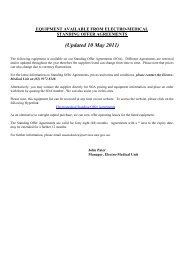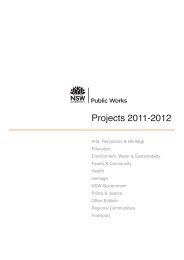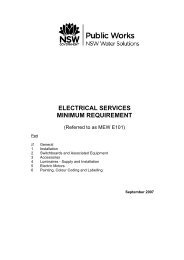Download MEW E101 April 2013 (pdf, 280kb) - NSW Public Works
Download MEW E101 April 2013 (pdf, 280kb) - NSW Public Works
Download MEW E101 April 2013 (pdf, 280kb) - NSW Public Works
You also want an ePaper? Increase the reach of your titles
YUMPU automatically turns print PDFs into web optimized ePapers that Google loves.
Part 1 - Installation<br />
108.8 Conduits in Concrete<br />
108.8.1 Generally<br />
Unless otherwise indicated, conduits shall not be run in the concrete topping. Conduits<br />
run in the fill under floor slabs shall be HD-UPVC.<br />
Corrugated conduits are not permitted.<br />
Conduits shall be securely fixed to the reinforcing rods, passing above a single layer of<br />
rods or between a double layer of rods, generally mid-way in the thickness of the slab.<br />
Attention shall be paid to routes of conduits in slabs to avoid cross-over and to keep the<br />
number of conduits in any one location to a minimum. Conduits in slabs shall be spaced<br />
not less than 75 apart.<br />
Conduits may cross providing they intersect at angles greater than 30 degrees and are<br />
tied together. The minimum cover over conduits shall not be less than the conduit<br />
diameter or 20.<br />
Conduits shall not be installed in a slab through the areas around a column to one<br />
quarter the distance from the column to the next column, supporting beam or wall,<br />
except to outlets in the area.<br />
Attendance during the concrete pouring to ensure that conduits are not displaced,<br />
broken or damaged is mandatory.<br />
Two working days notice shall be given to the Superintendent's Representative to<br />
inspect all conduits prior to pouring concrete. Sufficient time for alterations or<br />
modifications found necessary during inspection by the Superintendent's Representative<br />
shall be allowed.<br />
108.8.2 Conduits in Suspended Slabs<br />
Unless otherwise indicated, the maximum diameter of conduits in suspended slabs shall<br />
be 25, spaced not less than 75 apart.<br />
108.8.3 Conduits in General Columns<br />
Unless otherwise indicated, a maximum of four 20 dia. conduits are permitted in each<br />
column. No more than two conduits shall cross any one face of the column and all<br />
conduits shall be placed centrally.<br />
Bends in conduits entering the columns shall have a minimum radius of 300. Structural<br />
columns shall not be chased for conduit installation.<br />
108.9 Draw-In Points<br />
For surface run conduit systems, draw-in points shall be provided at suitable intervals not<br />
exceeding 30 metres for straight runs and at intervals not exceeding 25 metres for runs<br />
including directional changes. Draw-in points shall be agreed with the Superintendent<br />
prior to installation. Where used, draw-in boxes shall be of adequate size to prevent<br />
undue deformation of the cables.<br />
For underground conduit systems, draw-in boxes are not permitted. Provide pit at<br />
maximum 50 metre intervals.<br />
Materials used to lubricate cables whilst drawing-in to conduits shall be non-conductive,<br />
non-abrasive and non-hygroscopic.<br />
108.10 Conduits and Pipes for Future Use<br />
All conduits and pipes for future use shall be provided with polypropylene draw cords. A<br />
length of cord 2000 long shall be left securely fixed at the ends of each run. Conduits<br />
and pipes shall be labelled in accordance with Clause 603.<br />
Conduits and pipes terminated outside a building shall be taken beyond the line of<br />
paving, the draw cord shall be secured and the conduit or pipe capped, waterproofed<br />
and the location marked in accordance with Clause 105.5.<br />
Page 18<br />
<strong>MEW</strong> <strong>E101</strong>





